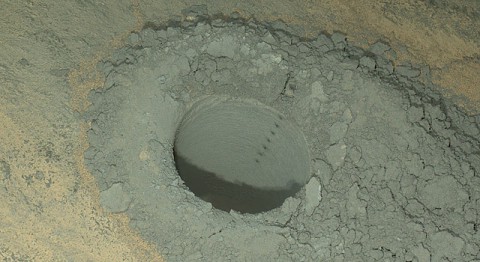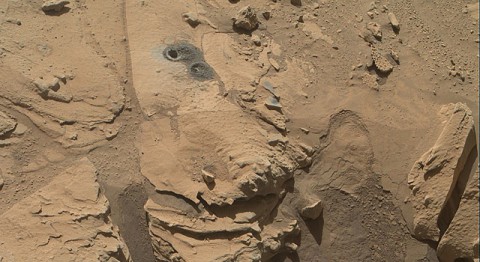Written by Guy Webster
NASA’s Jet Propulsion Laboratory
 Pasadena, CA – Portions of powdered rock collected by drilling into a sandstone target last week have been delivered to laboratory instruments inside NASA’s Curiosity Mars rover, and the rover will soon drive on toward its long-term destination on a mountain slope.
Pasadena, CA – Portions of powdered rock collected by drilling into a sandstone target last week have been delivered to laboratory instruments inside NASA’s Curiosity Mars rover, and the rover will soon drive on toward its long-term destination on a mountain slope.
Other instruments on the rover have inspected the rock’s interior exposed in the hole and in drill cuttings heaped around the hole. The target rock, “Windjana,” is a sandstone slab within a science waypoint area called “The Kimberley.”

The rover team has decided not to drill any other rock target at this waypoint. In coming days, Curiosity will resume driving toward Mount Sharp, the layered mountain at the middle of Mars’ Gale Crater.
The rover is carrying with it some of the powdered sample material from Windjana that can be delivered for additional internal laboratory analysis during pauses in the drive.
The mission’s two previous rock-drilling sites, at mudstone targets, yielded evidence last year of an ancient lake bed environment with key chemical elements and a chemical energy source that long ago provided conditions favorable for microbial life.

NASA’s Mars Science Laboratory Project is using Curiosity to assess ancient habitable environments and major changes in Martian environmental conditions. NASA’s Jet Propulsion Laboratory, a division of the California Institute of Technology, Pasadena, built the rover and manages the project for NASA’s Science Mission Directorate in Washington.
For more information about Curiosity, visit http://www.nasa.gov/msl and http://mars.jpl.nasa.gov/msl/. You can follow the mission on Facebook at and on Twitter .


